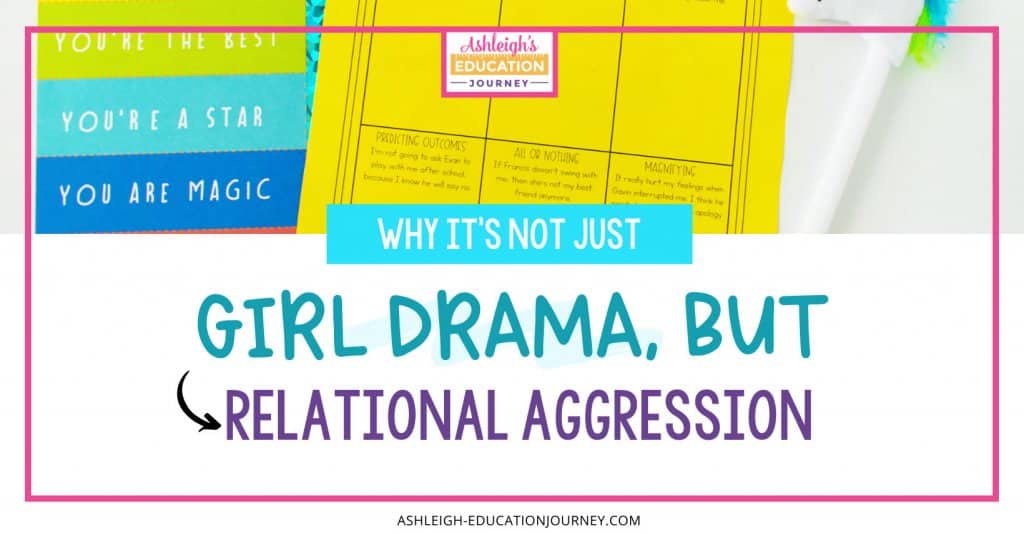
As a teacher, I felt like one of my weakest areas was dealing with what is often called “girl drama.” When I saw this as a teacher, I struggled to find the root of the issue, to have time to deal with the problem, and to know what to do about it. I was also uncertain of where to draw the line between normal friendship issues and problematic behavior. My tendency was to encourage the student to find someone else to play with or to ignore the situation.
However, as I saw these behaviors increase in frequency and intensity, I couldn’t ignore my instinct that there had to be more I could do as a teacher. That’s why I made it my mission to learn more about “girl drama”. Each of the lessons I describe below can be used on its own. I have created accompanying printables that you can see here.
One of the first strategies I learned is to not discount these behaviors as “girl drama”. The behaviors can be serious issues with lasting effects, and it’s certainly not limited to girls. Many of these more serious behaviors can be labeled with relational aggression. Relational aggression is behavior that is intended to harm someone by damaging or manipulating his or her relationship with others. Examples of behavior aggression include:
- gossip and rumors
- alliance building
- taunting
- social exclusion
Below are seven lessons I teach my students to prevent relational aggression and to equip students to handle conflict, as well as stand up for themselves.
In this post:
- Lesson 1: What Not To Do
- Lesson 2: Gossip and Rumors
- Lesson 3: Building Alliances
- Lesson 4: Taunting
- Lesson 5: Social Exclusion
- Lesson 6: Refusal Skills
- Lesson 7: Conflict Resolution
Lesson 1: What Not To Do
Not all conflict is relational aggression. If the action or words are rare or accidental, the conflict is probably not a result of relational aggression. However, many children struggle responding to ANY type of conflict with peers, so it’s important to discuss what NOT to do.
- Overgeneralize – make a broad conclusion based on a single incident.
- Catastrophize – put more weight on the worst possible outcome that makes sense.
- Mind Reading – infer another child’s thoughts based on behavior or facial expressions.
- Predicting Outcomes – assuming you already know what will happen. “I know they won’t let me, so I won’t even ask.”
- All or Nothing – she didn’t play with me today, so we’re not friends anymore.
- Magnifying – to make a big issue out of something small.
As I work with students on these thought processes, I encourage them to reframe their thinking into positive thoughts.
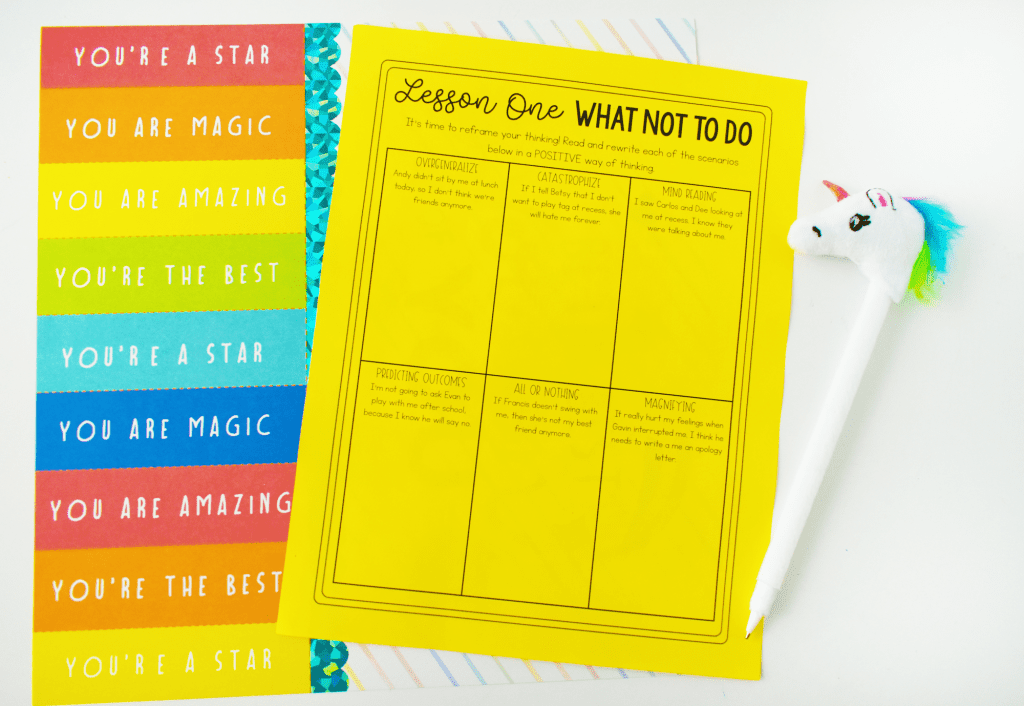
Lesson 2: Gossip and Rumors
In my next relational aggression lesson we begin to talk about gossip and rumors. It’s normal for students to be involved in each other’s lives, and curiosity is a natural part of childhood. However, there is definitely a line that can be crossed. I love using Trudy Ludwig’s book Trouble Talk to introduce the topic of gossip and rumors.
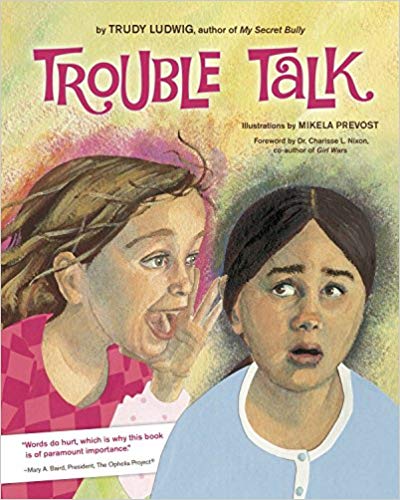
After reading the book, I define the terms gossip and rumor. Gossip is information about the behavior and personal lives of other people. A rumor is information that has been passed from one person to another person that has not been proven to be true.
I ask students to share experiences where gossip or rumors hurt them. Caution-please preface the conversation about NOT sharing anything their parents wouldn’t want them to share. I also share personal experiences of when someone gossiped about me. I also share about a time I gossiped and how I hurt a friend by doing so. It’s important for our students to see that we all make mistakes and what we did to correct those mistakes. We also discuss what to do when we hear gossip or rumors:
- Refute the rumor.
- Meet the negative with a positive.
- Say something kind to the victim.
- If needed, get help from an adult.
It’s so important to allow students to practice this with role play. If I’m short on time, I may break a lesson into two days, but I think it’s worth the time. Here are a few role play ideas:
- You walk up to a group of people and find that they are saying things that are untrue about one of your friends.
- You receive a text message with an embarrassing picture of another student in the class.
- Two of your friends come up to you at separate times to complain about each other.
- Your parent tells you personal information about one of the teachers in your school.
Once again, I follow the lesson with some application practice.
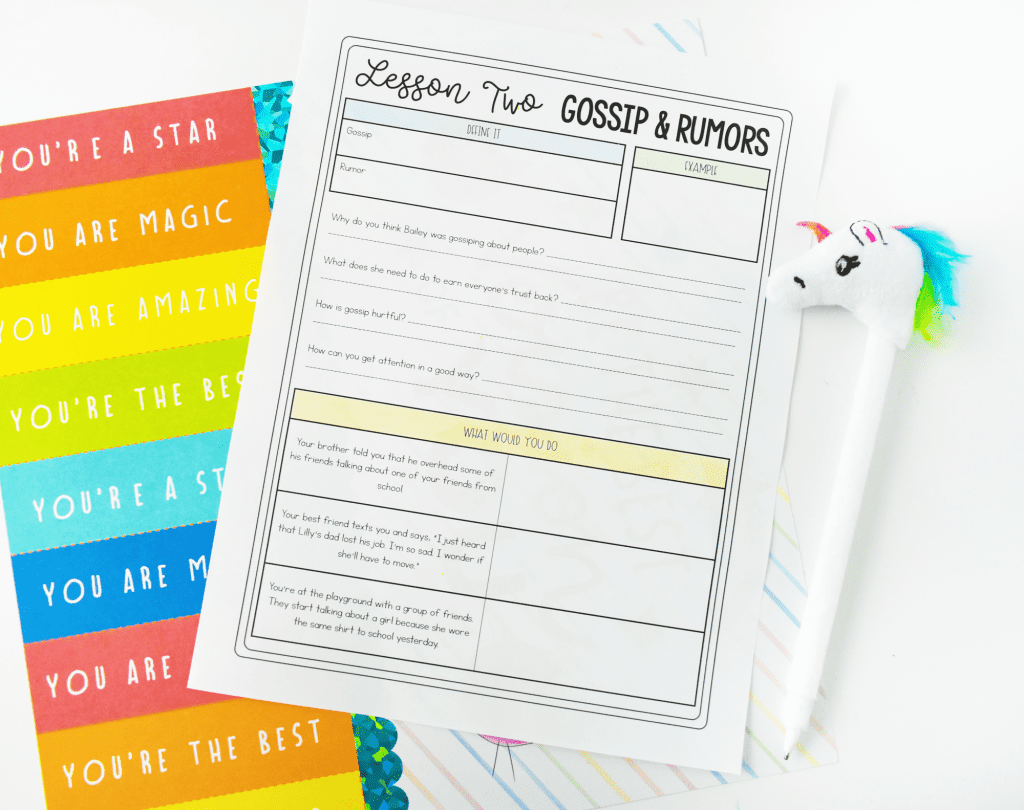
Lesson 3: Building Alliances
Close friendships are not a bad thing. We all want relationships with people who will stick with you through thick and thin and offer support, empathy, and understanding. The problem with alliances comes when they result in social exclusion of others. Once again, Trudy Ludwig has a great book called My Secret Bully for discussing alliances with students.
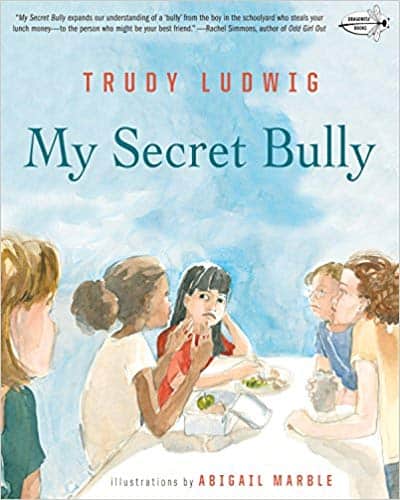
After reading the book, I define an alliance as a relationship between two or more people with an intention to exclude or act aggressively towards another person. We then spend time discussing alliances. I explain that it is a problem to get other friends mad at someone who has hurt them – to take joy from punishing someone with the help of our friends. It is one thing to turn to your friends when you have been hurt or are angry with someone. It is another thing to get your friends angry with someone else or turn them against someone else. After discussing and sharing, we role play to practice noticing and stopping alliance building.
Some topics for role playing include:
- One girl in the class tells you to avoid another student because that student said something mean about her.
- Marcus tells you that if you play baseball with Antwan then he won’t be your friend anymore.
- Henry says he will unfriend anyone who goes to the birthday party he wasn’t invited to.
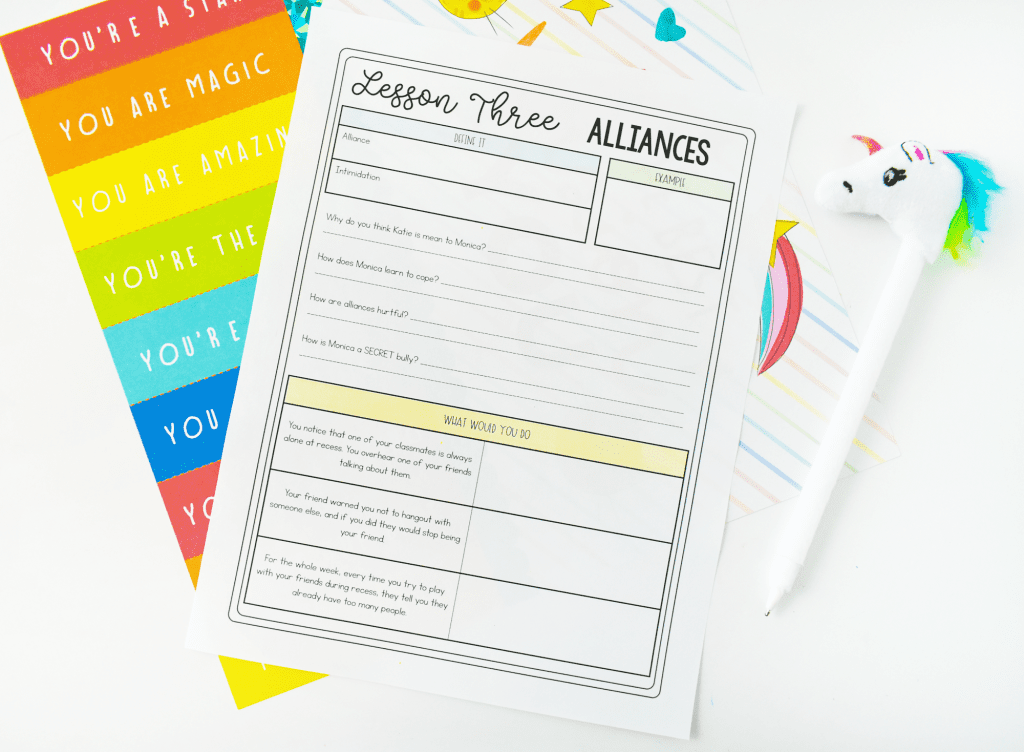
Lesson 4: Taunting
As I researched, I learned that good-natured teasing is a healthy part of a relationship and growing up. The problem occurs when teasing turns into taunting. It is also relational aggression when children try to embarrass others and throw in a “just kidding”. Regardless of how it’s done, public humiliation is never okay. Trudy Ludwig did it again with Just Kidding. However, reading the book on it’s own is not enough. You have to follow the book with conversations.
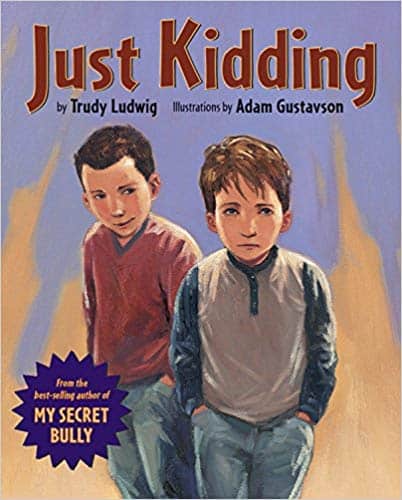
When defining teasing and taunting, I like to make a list of both, because it’s very helpful to see the difference between the two.
Teasing:
- lighthearted and fun
- switches roles
- words are not hurtful
- intended to make the other child laugh
- stops when asked
Taunting:
- one sided
- doesn’t stop when asked
- humiliating or cruel
- intended to harm
- wants others to laugh AT target
It’s important that students also understand that they may think something is just teasing, but the target is still hurt. Some people are more sensitive than others are or they are having a bad day. If our intent is to just kid around, then we should immediately stop when we see it hurts and make it right. It’s also important to remember that we cannot assume the other person is taunting us until we ask them to stop and they do not.
We should also point out the taunting isn’t always with words. Our body language and actions can also be a form of taunting. For example, if a student makes gestures or rolls their eyes behind someone’s back, that is taunting. It’s also wrong to make a joke of hiding personal property.
Once again, we follow the conversation with discussing social situations and role playing. Some topic ideas include:
- One student makes fun of your best friend, but always says, “Just kidding.”
- When you make a mistake on a group project, another student calls you stupid.
- A student trips in the hallway and everyone laughs and calls her clumsy.
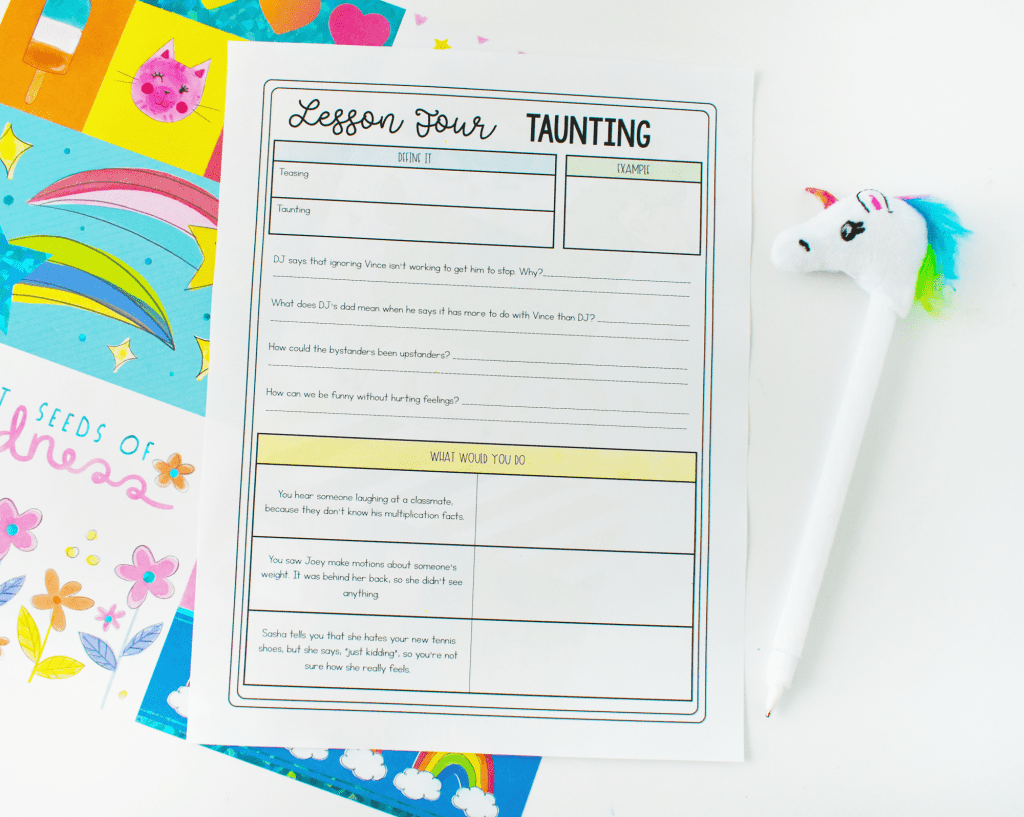
Lesson 5: Social Exclusion
Social exclusion, otherwise known as cliques, are nothing new. But, they do seem to be forming at younger and younger ages. This is a topic where I certainly try to clarify that no, you won’t be close friends with everyone. However, it’s not kind to leave anyone out. To introduce the concept of social exclusion, I read Cliques, Phonies & Other Baloney. This isn’t a book that I read cover-to-cover. Instead, I preread and pick and choose what I read aloud to students.
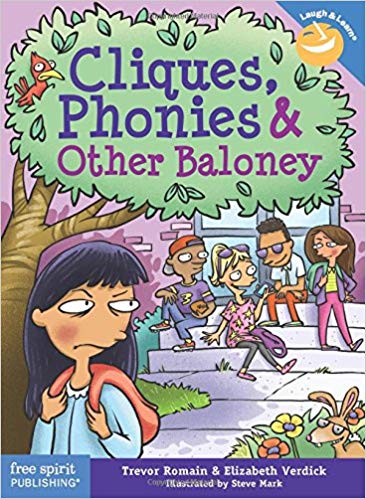
After reading the book, I define the terms clique and exclusion:
- Clique: an exclusive peer group
- Exclusion: where a person or group of people do not permit someone to be a part of a peer group; can be intentional or unintentional
We discuss how friendship groups come together for the same basic needs, but are not exclusive. Positive friendship group speak to others in the halls, allow others to sit with them at lunch, and include outsiders in the group. Role play ideas include:
- A new student comes to class, and you know he does not know anyone.
- You do not play on the school’s basketball team, but you would still like to play basketball with the other children at recess. They tell you that you are not allowed because you are not on the team.
- Two students cut in line in the cafeteria saying, “Cool people go first.”
Lesson 6: Refusal Skills
After teaching about the types of relational aggression, it’s important to teach students refusal skills. It does not come easily to many children to speak up for themselves, so many students have to be taught how to speak up for themselves. Some strategies I teach include:
- Broken record-choose a stance and say it over and over until the other person gives in or walks away.
- Ask questions-ask questions such as, “why do you want me to do that?”
- Keep the door open-I don’t want to do that, but if you change your mind and want to do something else, let me know.
- Call it like it is-Let the person know that what they’re saying or doing is mean.
In certain situations, students must use assertive communication. When communicating, students should stand tall, make and hold eye contact, and use a clear voice. Students should also be able to speak with confidence and without guilt. Some students may need considerable role playing with refusal skills, and you may discover that some need to learn the difference between assertive communication and aggressive communication.
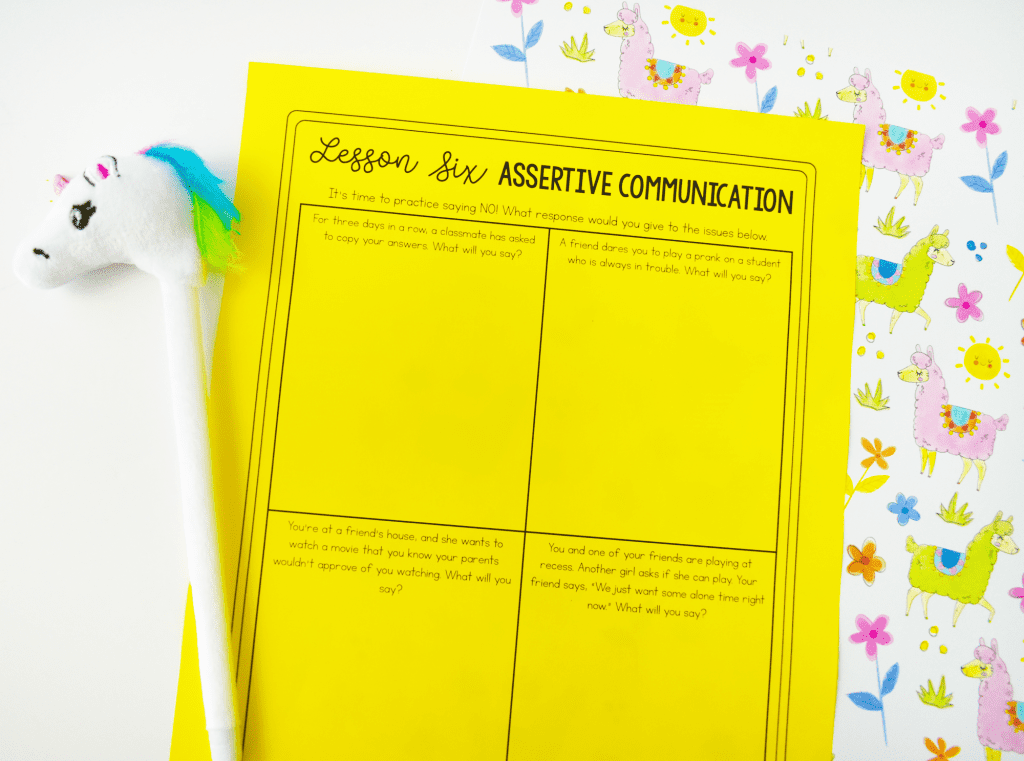
Lesson 7: Conflict Resolution
Despite our best efforts or our students’ best efforts, there is bound to be conflict within friendships and peers. Our students must be equipped to independently handle these conflicts in an appropriate way. Many times, our students revert to negative behaviors, so I like to teach this lesson with relational aggression Dos and Don’ts.
Do:
- talk about how you are feeling
- use I statements to avoid the blame game
- take responsibility
- be calm
- listen
- consider your friend’s perspective
Don’t
- exaggerate to make the situation bigger than it is
- gossip
- build alliances to get others friends in the conflict
- use the silent treatment to retaliate
- pretend you don’t care with “whatever” statements
- dismiss your friend’s feelings
Conflict resolution is not something that you can teach in a day. Instead, it helps to make an anchor chart that displays these steps. As students encounter conflict, guide them as they navigate through this process until they are comfortable with conflict resolution. If you’d like to see more of the printables, you can click here.
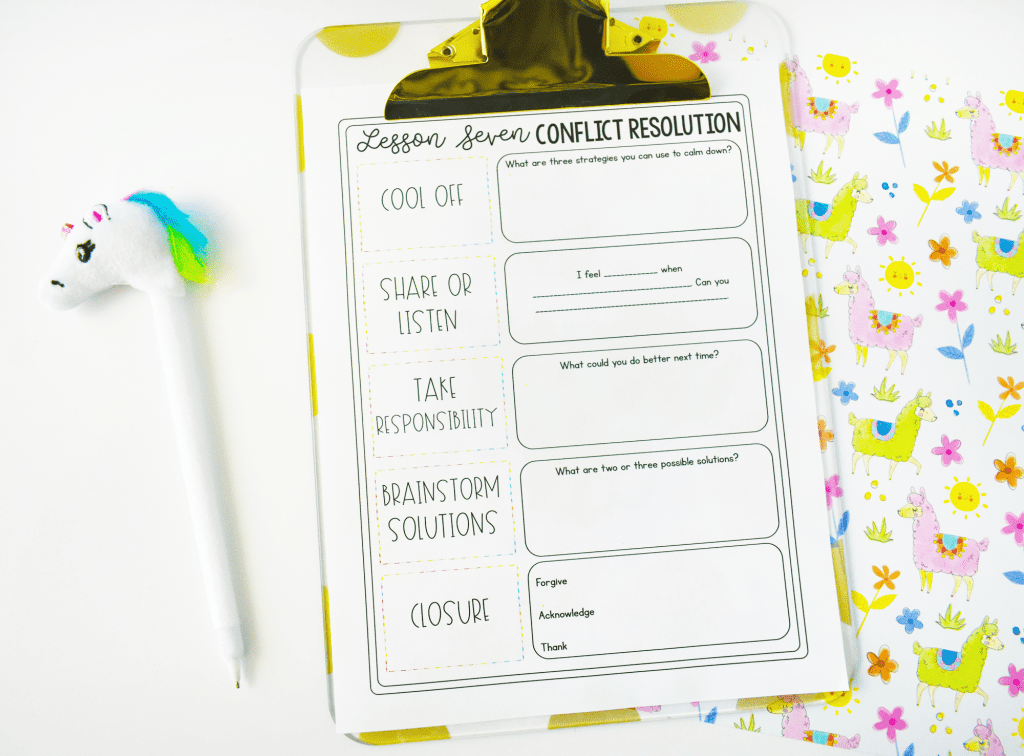
I completely get that this won’t fix everything. I also understand that ideally, relational aggression issues would be taken care of outside the classroom. But, our reality is that our students need these lessons. I want to equip and empower my students to be confident in who they are, how to recognize and avoid relational aggression, and how to stand-up for others. You can find each of the lessons here.

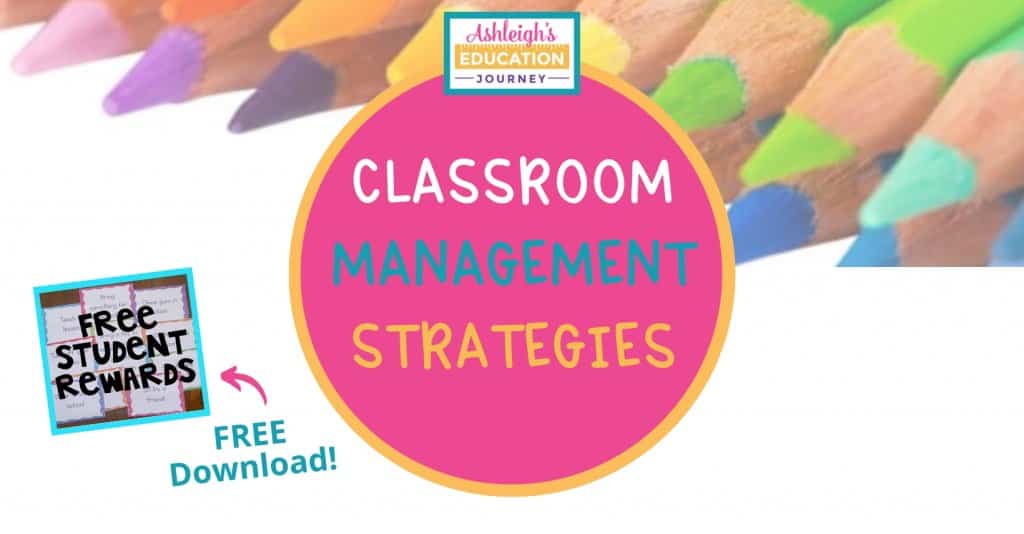
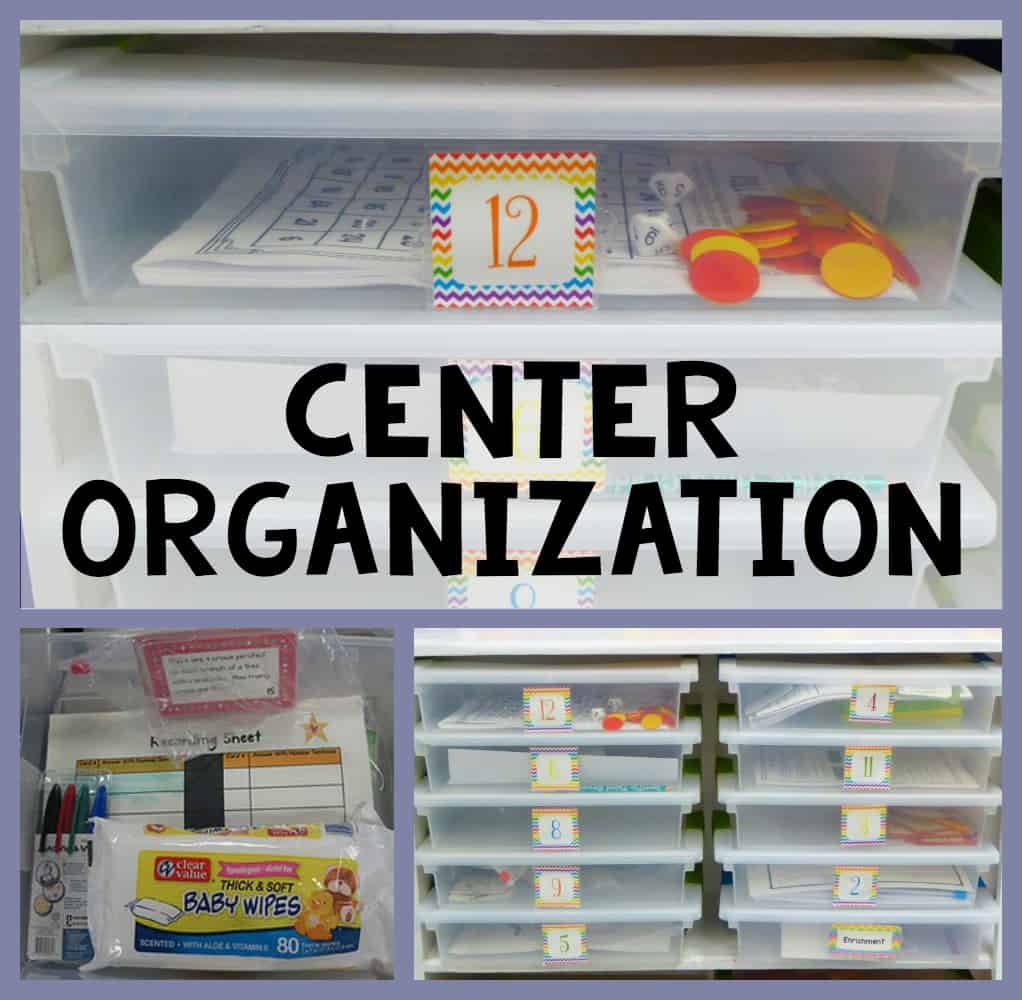
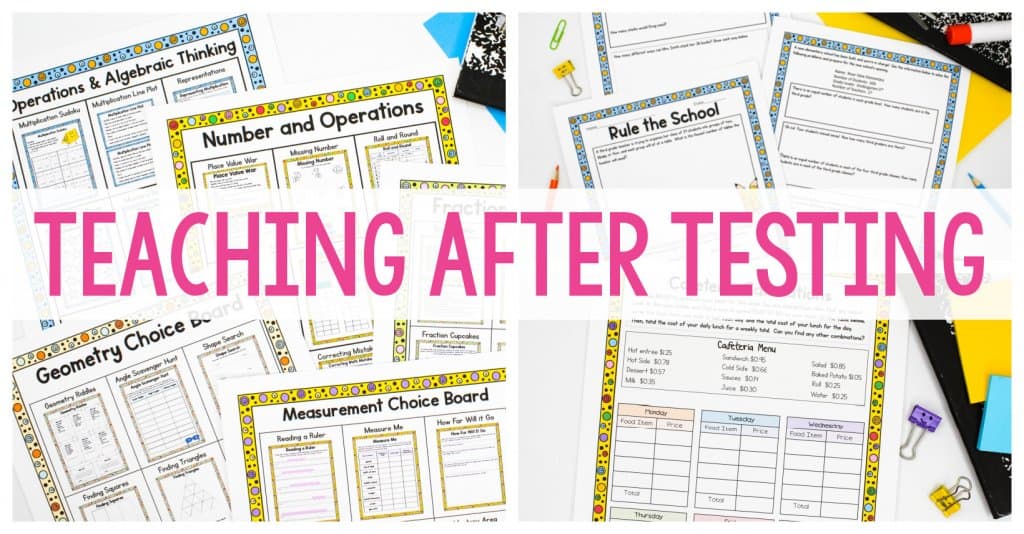
Thank you! I’ve never read a better post on how to address friendship issues in the classroom. I appreciate your research and sharing. Have a wonderful school year!
Jan
Laughter and Consistency
Thank you for these simple lessons. Luckily I all but one of the books. My district is BIG with Social Emotional Learning, but like you I too had a hard time with the “Girl Drama” which I now also see happening with the boys so this will be good for all my students. This is the start of my 30th year and I’m always excited to try something new! Thanks for adding to my repertoire. Have a wonderful school year!
These look so good and thoughtful. Well done! Is there a way to download the pages that go with these or is it on your tpt site? Thanks!
Hi Ashley,
I love these lessons. I am moving from grade 2 to grade 5 this year and would love to have this resource. I was wondering if I could get a copy of the worksheets you have developed on “Why it’s not just girl drama.” Are they available on TPT ? If they are how can I find them ? If not would you be willing to share them with me.
Thanks, Heather
Yes, they’re on TpT. There should be a link in the post:)
I cannot find the link in the post.
I can’t find these lessons to purchase on Tpt
You can find them here!